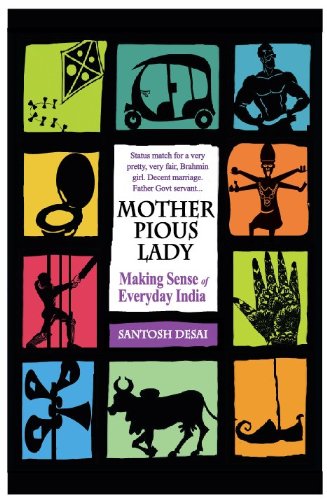Amidst those who are born with a silver spoon in their mouths to the impoverished ones struggling to get two meals a day, there exists in India a class that manages to get just enough under the sun. The great Indian bourgeoning Middle Class comes as the filling material that tries to plug the fissures through its aspirations and idiosyncratic ways. ‘Mother Pious Lady’ authored by Santosh Desai gives a kaleidoscopic view of the myriad faces of a segment of a society that almost ten years back used to dangle between a Bajaj scooter and ‘Mere paas maa hai’ syndrome.
It begins with those characteristic features that define life for those trying to eke out a living within the parameters of limited credit amount. Flipping through the pages of the book can very well turn out into a means to hit off the nostalgic lane and revisit those days when urban middle class was trying to figure out the nuances of a plethora of changes that came knocking at their doors. Those ‘n’ number of polythene bags underneath the mattresses, old saris being re-woven into a quilt, those subtle exchange of reactions between a couple without clambering on to PDA (public display of affection), potions of affection served for all in the form of a sumptuous ‘Thali’; these being few of the many finer details that find mention in the book.
As far as the title is concerned it goes on to explain that psyche of the middle class that believes in perfect presentation on all fronts especially when it’s about a hunt for a prospective match for a daughter. Benevolence has to displayed in every singular action related to looking out for ‘Status Match’, and subsequent paraphernalia associated with BHP (refers to bio-data, horoscope and photograph in matrimony terminology). Needless to say, ‘brother settled in US’ always gives a vantage point to the concerned party. Lavish spending was unknown in daily chores of life and every penny is saved to make the most of it when beti is all set to tread towards her sasural.
From typical bowel habits to the act of unremorseful farting in public, nothing has been spared, not even the clichéd abhorrence for western-style toilets. Buying of vegetables with a grocer is a smart deal if it ends with the procurement of ‘hari mirch and dhania’ absolutely free! There is an inexplicable fondness for timeless flicks like ‘Chupke Chupke’, ‘Bawaarchi’ and ‘Gol Maal’ that remains adhered to the en masse since all these films are imbued with a sense of (in terms of the writer) MCFE (middle class family entertainer). Similarly that magic hovering around old songs is often tried to be revived back via the means of remixes that’s often way too jarring to soothe the sense of audition.
Along with these affable ways there also lay within a hypocrite that would try to put forth a subterfuge to conceal those awkward patches in one’s life. Good example can be drawn from those who believe that ‘preparation for IAS’ or for that matter doing M. Phil, etc. is an easy route to stay in a perpetual state of idleness. Yet the aam aadmi had that ninety-degree inclination towards ‘Neel’ (blue powder) that would render to clothes glistening whiteness and sprinkle on the man who wore that shirt a raging confidence in a crowd of growing mandarins. Journey or ‘Yatra’ was nothing less than a harrowing experience that was inflicted with a panic as far as travelling was concerned; an inland letter and a postcard was looked forward to with palpable excitement associated with the former and rousing anxiousness adhered with the latter, for each of them connoted a sense of personal attention an individual was getting. Scooty did revolutionize the life of a small town girl as she experienced a freedom worth envying compared to her metro counterpart thus allowing her to saunter along the alleys of the city without depending on Papaji and Bhai.
The book changes its gear from being retail in approach in the beginning to assuming pan-India proportion towards the end thus making it difficult to assimilate for a friendly comrade. When the focus is shifted to scarcity of IITs and IIMs, lawyers ending up as spokespersons for political parties, menace such as inflation and terrorism, one tends to withdraw into hibernation as these pertain to the system and not the class the book claims to boast upon. Moreover there are a slew of minutiae that was perhaps overlooked by Mr. Desai. For instance that gourmet charm associated with Pakodi when a guest arrives, the scrutiny that follows a new bride, Bahu in all her overtures from cooking to conducting herself at family functions, penchant for curtains among the middle class as if something has to be muffled out there, that sense of sacrifice in this generation of parents who would not consume goodies but go an extra mile in facilitating convent education to their kiddos. After all, there do exist many subsets that add together to give rise to the large cauldron of the middle class. While some of the foibles and blips make it a dire necessity for the existence of this class, there is a scope for the expansion of the periphery of its thought thereby opening gateways to the emergence of an even strong resilient and morally un-recapitulative part of the society.

No comments:
Post a Comment